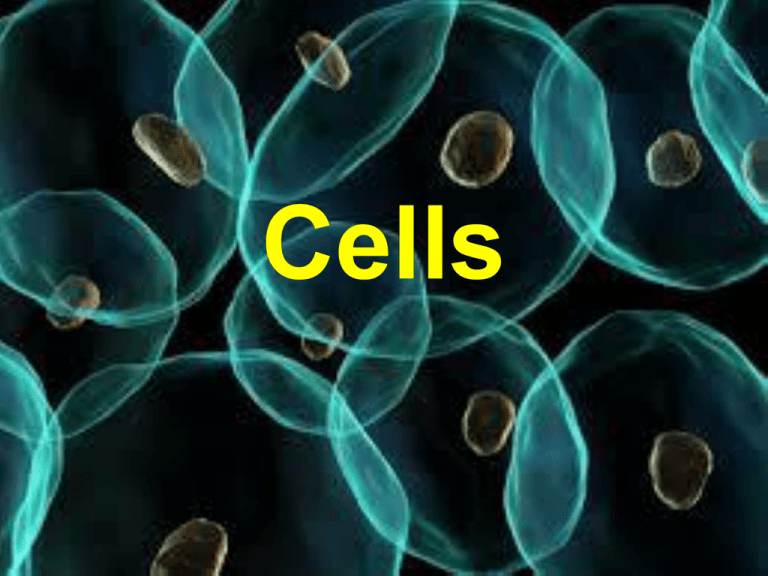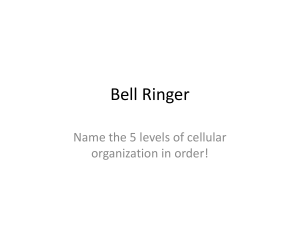Cells
advertisement

Cells Cells • On the Earth, there are many different living things. Each living thing has something in common. They are all made of cells. • What is the name for a living thing? • An organism • All organisms, no matter how large or how small are made of cells. • The cell is the smallest unit of living things that can carry out the basic processes of life. • Cells divide and split into two new cells. Every cell in every living thing on Earth originally came from another cell. What are all living things made of? • Cells Unicellular • What do you think the term unicellular means? • One-celled • An organism that is unicellular is made up of one cell that carries out all its life processes such as growing, reproducing, responding to its environment, and getting food. • Examples are: amoebas and euglena • That’s one busy little cell ! Multicellular • What do you think the term multicellular means? • Many-celled • A multicellular organism is made of more than one cell. • Can you think of some examples of multicellular organisms? • Frogs, trees, YOU! How many cells does an organism have? Some have only one cell. These are called unicellular organisms. Others have many cells. These are called multicellular organisms. Where do cells come from? •Other cells Can you name examples of organisms? • • • • • • Bacteria Fungi Algae Protists Plants Animals Robert Hooke • Robert Hooke was an English scientist. In 1665, he looked at a slice of cork in his microscope and saw many little boxed and he called them cells. How are unicellular and multicellular organisms similar and different? • They are similar because they are both made of cells. • They are different because unicellular organisms are made of just one cell while multicellular organisms are made of many cells that work together to take care of different functions. Why do you think there are more unicellular organisms than multicellular organisms? • Most unicellular organisms are much smaller than multicellular organisms and have simpler structures. They do not require as many resources or as much space. Why do organisms need cells? • Cells are able to perform all the activities that keep organisms alive. • What is inside an animal cell? (brainstorm as a group). Organelles • Organelles are basic structures that help cells perform life processes. They have functions that keep the cell alive. • Some important organelles are: • Nucleus • Mitochondria • Vacuoles • And more… Which organelle controls the cell’s activities? •The nucleus What do mitochondria do? • They supply energy for the cell by breaking down food. Where are wastes stored in cells? • Wastes are stored in the vacuoles. • Where are an animal cell’s organelles found? • They are found in the cytoplasm (gel like liquid). • What is the function of the cell membrane shown in the diagram of an animal cell? • It protects the cell and its organelles, gives the cell shape, and controls what materials move in and out of the cell. How are mitochondria similar to tiny power plants? • Mitochondria are similar to power plants because they provide energy for the cell. Talk time! Do you think a cell could function without a nucleus? Explain your answer. • Do plants need to eat food? • No, they make food. • What helps plants get energy and make food? • Sunlight Plant Cell • What is the shape of the plant cell? • What are the parts of the plant cell? • Does the plant cell have parts that the animal cell does not have? • Yes, the plant cell has a cell wall and chloroplasts which the animal cell does not have. • Cell wall- provides strength and support • Chloroplasts- a green structure where the energy from sunlight is used to produce food for the plant. They contain chlorophyll that causes the chloroplasts and some plants to be green. • What parts do both the plant and animal cell contain? • Nucleus, cytoplasm, vacuoles, a cell membrane, and mitochondria Which cells have a stronger outer covering- a plant cell or an animal cell? • A plant cell has a stronger outer covering. A stiff cell wall surrounds the plant cell. An animal cell does not have a cell wall surrounding it. • As the number of cells in an organism increases, cells must specialize in one or a few activities in order for the organism to function well. In complex organisms, organization starts at the cell level. • Cells are building block of the body. • Similar cells working together at the same job form a tissue. • A group of tissues that work together to perform a specific function form an organ. • Organs that work together to perform a certain function make up an organ system. • Organ systems that work together form an organism. Cell Organization • • • • This is an animal cell. The tissue is a muscle tissue. The organ is a heart. The organ system is the circulatory system. • The organism is a salamander. How does the complexity change as you move from a cell to an organism? • Each level becomes more complex. Cells form tissues, tissues form organs, organs form organ systems, and organ systems form organisms. Cells Tissues Organs Organ System Organism Organ Systems work together to bring food, oxygen, and other materials to cells. • Think of two systems that would work together in a salamander. Which organ system sends food to which other organ system in the salamander? • The digestive system sends food to the circulatory system. Then the blood vessels in the circulatory system take this food to the cells. How do organs compare to organ systems? • Organs are made of tissues and make organ systems. In organs systems, organs work together to carry out a function of an organ system such as digestion. How are complex organisms organized? • Complex organisms are made up of cells that form tissues, tissues that form organs, and organs that form organ systems. Think about it! Why is it important for us to learn about cells? Take 2 minutes to think about this question. You will share your answer with your group.







